The path to a first boatbuilding adventure is not always straight, nor even obvious. For some, boats have been a lifelong passion, stemming from childhood when school notes were embellished with doodled sailboats, or scrap-wood vessels were towed on the end of a string across driveways and puddles. For others, like Reid Schwartz, the journey was more oblique.
Reid Schwartz grew up in the Lake Sunapee region of New Hampshire, and while his family didn’t have boats of their own, he often went paddling with neighborhood friends whose family owned two canoes. But Reid was drawn more to arts and crafts than boats, and after high school he went to the Massachusetts College of Art to study sculpture and printmaking. It was there that he discovered a love of tools. “While trying to learn blacksmithing,” he recalls, “I made blades and hatchets…my professors were not amused.”
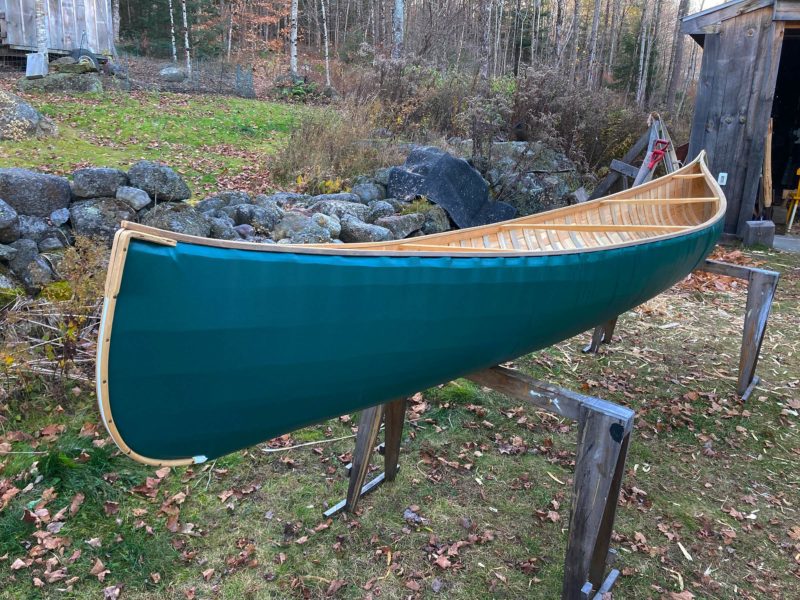 Reid Schwartz
Reid SchwartzIn the course of researching indigenous crafts and canoes, Reid learned that when suitable birch for canoe building was hard to find, Native Americans improvised, initially trading for bark from other regions, or, by the late 1800s, for manmade materials such as canvas. By the late 20th century, the preferred fabric in parts of Canada was waterproofed tarpaulin. When Reid built his own canoe in this more recent tradition, he used a PVC-coated truck tarp for the skin.
After graduating in 2006, Reid took an apprenticeship with a cabinetmaker and learned skills that would allow him to make a modest income by taking odd jobs. He moved to New York City to work in commercial illustrating, but it was in making things in his spare time that he found his true calling; after the crash of 2008 he rented a studio in which to start “making for work. I built furniture, cabinets, outfitted galleries with displays, took repair jobs on old windows, and dabbled in restoration carpentry.” He also carried on with his blacksmithing and taught himself how to make woodcarving knives.
In 2016, he took a very part-time gig in a boatyard in Westport, Massachusetts, restoring the interior of a fiberglass sailboat built in the 1970s. And, around the same time, he brought into his own shop a late-1800s Rushton wood-and-canvas canoe for restoration. During the weekdays he was tearing the sailboat back to rough, splintered fiberglass, and in the evenings and weekends he was falling in love with the canoe. “Something about the mass and complexity of the sailboat left me craving boats I could actually pick up and carry. But it was also the lines of the canoe. It was very much an interpretation of Abenaki birchbark canoes, which were still being traditionally made in the late 1800s and were considered some of the most desirable canoes of their day.”
The canoe restoration led Reid to look into the history and origins of the Abenaki type. As he delved ever deeper into native canoe-building he came across César’s Bark Canoe, an hour-long documentary by Bernard Gosselin that follows César Newashish, a 67-year-old Atikamekw of the Manawan Reserve north of Montréal, as he builds a birchbark canoe, from felling the tree in the forest to paddling the finished boat on the reserve’s lake. Watching the “sublimely skilled and deft-handed craftsman build his boat with the materials at hand in the boreal forest, was absolutely jaw-dropping,” Reid says. “Virtually all the timber he worked was split, hewn, and shaved to outrageously fine proportions using the most wondrous indigenous tool—the crooked knife.”
For Reid, seeing “such critical and intuitive understanding of material” had the effect of “grabbing a thick bundle of loose strings in my head—toolmaking, woodworking, art, history, my love of nature and interest in trees and their growth, the desire to work from the log and to choose my own tree—and tying them together in my mind.”
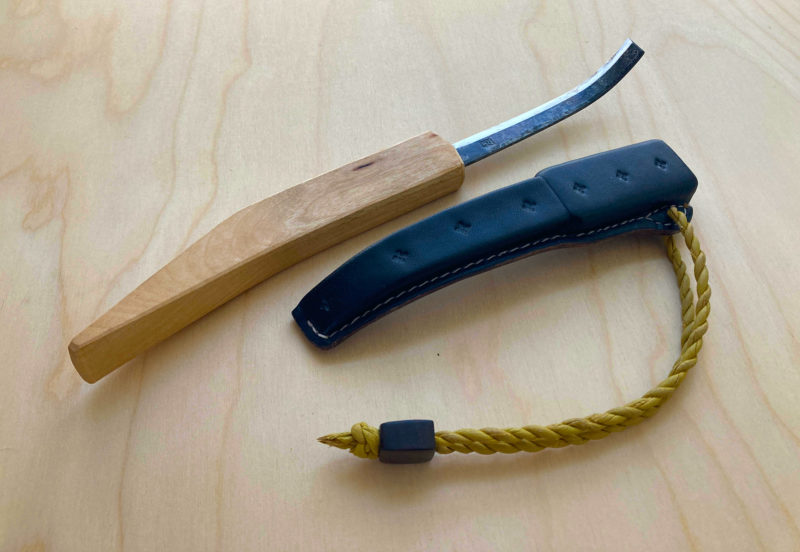 Cody Nowell
Cody NowellCreated in the Cree tradition, Reid’s crooked knives have yellow-birch handles carved by axe and knife, finished with tung oil, and hand-forged steel blades. Unlike the scooping cut of a spoon knife, the crooked knife carves out a gentle hollowing cut.
But Reid was still far from building a bark canoe. He set out to make a crooked knife and learn how to use it. “It is a notoriously difficult tool to use when you first pick it up,” he says. There is no standard one-size-fits-all crooked knife. This Native American multipurpose tool is designed to be used, most often, gripped palm up and drawn toward the user to shave and carve wood. It is particularly adapted to carving long, flat objects like the frames and ribs of a birchbark canoe. The shape of the crooked knife varies from tribe to tribe and from craftsman to craftsman. There are, says Reid, not many native-made crooked knives around, and those that do exist “represent the quirks of the maker. The tool is very particular—different users and cultural groups prefer different functional details. They are tools that can be broadly similar but individually distinctive.”
Over time, Reid studied and tried many knives until he found some shapes that worked for him. Eventually he started making knives for himself and then making them to sell.
His knives don’t suit everyone, he says, nor do they suit every task, and “you only really know if a knife is right for you if you’re using it on the right material—wood split from a round.” This led Reid to another step on his path to boatbuilding: green woodworking. “I had to learn how to use wood that’s fresh cut. It was exciting but challenging. I started to see firsthand how variable wood growth is and that if I wanted to have a decent time splitting, hewing, and shaving, I had to be more careful about my choices in the field.” Reid began to see not only the tree but also how the ecology and landscape affects the tree and its wood. As he explored his family’s property looking for suitable woods on which to practice the carving skills for building a traditional canoe, he started thinking about bark.
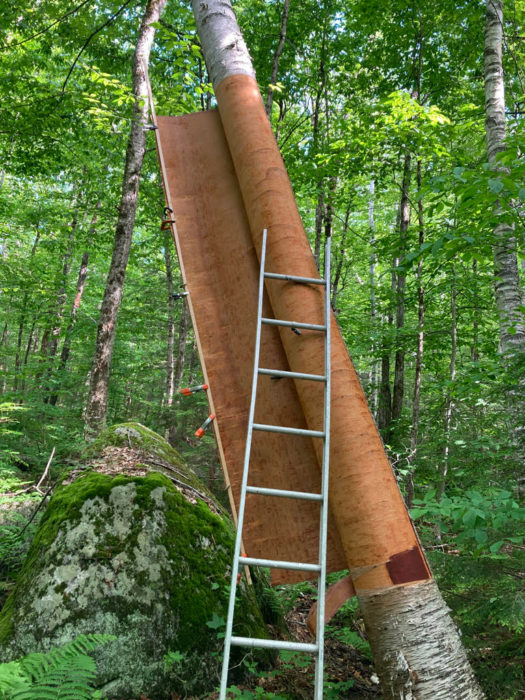 Reid Schwartz
Reid SchwartzWhen harvesting summer bark, a vertical cut is made according to the length of bark required. Because the cut is made vertically very few of the capillaries working sap and nutrients up and down the trunk are disturbed, and since the bark fibers run in circumference it will tear off cleanly at the top and bottom of the harvest site, with no horizontal cuts needed. If harvested in the late spring, when new bark is being first formed, the bark almost pops off the tree and is at its most smooth. A healthy tree will survive losing as much as 20′ of bark if harvested correctly.
“Suitable canoe bark,” Reid says, “is very hard to find; it’s not as simple as finding a birch tree with white bark. A usable canoe birch tree, Betula papyrifera, needs a lot of girth without flare—it needs to hold its girth all the way up, staying nice and straight. It can’t have bumps or scars, and, even then, the bark has to be the right thickness and when you bend it through 90° in either direction, the layers must stay firm, without delaminating or splitting. It’s a really tall order. You have to cover a lot of ground and look at a lot of trees.” Reid became a forager, hunting through the woods near his home for the right canoe birch tree.
He snapped up every book on bark canoes that he could find. He discovered the writings and drawings of Edwin Tappan Adney, who is famed for his documentation of the history and different styles of indigenous bark canoes. Reid read and learned; he practiced splitting and shaving with his crooked knife, but still he wasn’t ready to build his own bark canoe.
In 2015, Reid went to the Peabody Essex Museum in Massachusetts to hear Passamaquoddy birchbark artist David Moses Bridges talk about canoe building. “He was very gracious about my overbrimming interest,” says Reid. “And we got talking about tools and bark and digging roots. He encouraged me to get my hands on the materials, and the very next day I peeled some bark to make my first model.”
Two years later, Reid and his wife moved back to New Hampshire, to settle near his parents on a piece of family-owned land. There, he met Bill Gould, an Abenaki basket maker, snowshoe maker, sawyer, and member of the Nulhegan Band of the Coosuk Abenaki Nation. Bill invited Reid to help him build two bark canoes—a 10-footer and a 12-footer—with materials they harvested. “Before we knew it, we had a 10′ canoe, a 12′ canoe, and a 14′ canoe in the works. From one to the next, our technique improved, and we learned a tremendous amount. Perhaps the greatest learning curve came when we were working with roots to make gunwale lashings. Roots have a few challenges. You have to be choosy about where you dig. The trees have to be spread out enough that their roots aren’t just tangled together in massive mats—plus if the ground’s too rocky the roots grow kinky. Then, once you’ve found them, peeling the roots is tricky. At first, we tried whittling the bark off, but it took hours and hours, and you need 600′ or more for a canoe. But, after a while, we learned that if you boil the roots, the bark and pitch just slide off, and once the root is soft, splitting it down the center is very easy.”
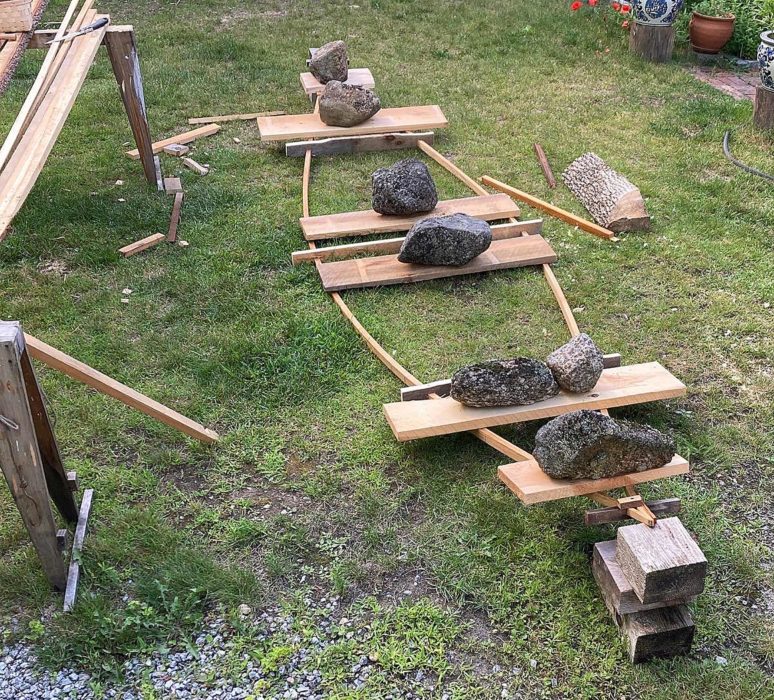 Reid Schwartz
Reid SchwartzThe gunwales, pre-soaked for a week, are shaped at temporary cross spalls at the thwart stations. Sheer is introduced by weighting the gunwale and raising the ends up onto blocks. The gunwales are left to take shape for a week.
Building a birchbark canoe starts with the skin of the boat. The bark is laid out, with its exterior facing upward so that the smooth inner layer of the bark becomes the outside of the canoe, and a temporary bottom frame is set on top of it, weighted down with rocks. The sides are folded up into a flat-bottomed, vertical-sided trough in the rough shape of a canoe. The gunwales—typically northern white cedar, but spruce and pine are also used—are fitted along the top of the bark, inside and out, and pegged through before being lashed around and through with split and shaved spruce roots woven tightly to bind the gunwales and form the sheer. The temporary frame is removed, and the final curved shape of the canoe is then created with the placement of tight-fitting pre-bent ribs, which are tapped under the gunwales bringing the bark into tension. As the ribs are set in place, planking, fashioned from finely shaved staves, is fed between them and the bark skin to produce a strong, watertight hull. The ribs force the hull into the desired shape, whether flare-sided, high or low tumblehome, narrow and round-bottomed, wide and flat-bottomed; it can also have as much rocker as the builder desires, from flat to heavily raised. The only restriction on shape is the bark itself. “The challenge,” says Reid, “is to tailor the shape in the very first step, when the bark is laid out.”
That summer, Reid and Bill built several canoes with varying success. “It took me several full-sized boats to figure out what was going on,” Reid says. “My first had way too much rocker; it was like a banana. It was solid and watertight but hard to paddle because it was so tender. The next was flat-bottomed, but the ribs were not tight enough and needed shimming, and once I’d done that, there were a lot of leaks.”
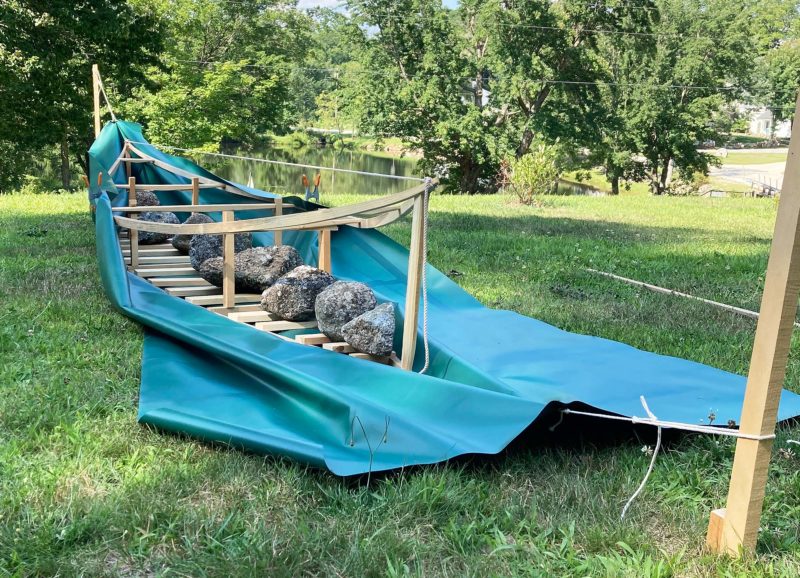 Reid Schwartz
Reid SchwartzThe tarp (as it would be with a birchbark skin) is laid out on the ground, and the temporary frame, weighted down with rocks, is laid out on top of it. The gunwales, with thwarts in place, are supported by struts anchored to the temporary frame.
By fall, Reid was more experienced but broke. He went back to making tools for sale and thinking about his next steps. In the course of their harvesting, Reid and Bill had realized that there were very few suitable birch trees for canoe building. If Reid built another canoe, finding bark to harvest was clearly going to be an issue. He began researching indigenous canoes built in regions where birchbark is scarce.
He learned that the Cree, one of the largest tribes in Canada, from the late 1800s had adapted their canoes to be built with canvas skins. “Indigenous builders,” says Reid, “are, without fail, ingenious and practical, combining their labor with an intimate understanding of natural materials. The Cree of the Ungava peninsula in Québec, used many of the same techniques as the Abenaki, but the native birches in their area are so small that to build a canoe you have to sew a quilt of small squares. So, they began trading for larger sheets of bark from other regions or even other materials. By 1908, canvas had become the dominant material and produced a canoe that was considered superior for its smoothness and light weight, but was less durable than the birchbark canoes.” In more recent times, “probably in the second half of the 20th century,” says Reid, “the Innu, in the eastern portion of the Québec-Labrador Peninsula, took this one step further and used a pre-coated tarpaulin, the kind used to cover goods on trucks. The great advantage of the tarpaulin over canvas,” he says, “is that it’s already waterproof.”
 Reid Schwartz
Reid SchwartzThe tarp is pulled up around the temporary bottom frame weighted down with rocks. The temporary thwarts have introduced flare to the canoe’s sides, and the gunwales further define the sheer.
Reid ordered some 18-oz PVC-coated truck tarps to have on hand for a canoe skin when he turned up the wood he’d need for the project.
Shortly after the tarps arrived, in April 2022, some large white pines on the family property were felled and sawn by a portable bandsaw mill to make boards for a barn his parents were building. “I crawled over the slash and pulled out the waste created by squaring off the round logs. I set about splitting some, and the wood was of much better quality than I’d expected. If it weren’t for the pitch all over my hands and clothes, it would be rather pleasurable to work pine this way.”
As with a native canoe, every part of Reid’s boat is based on measurements of the body: “from fingertip to fingertip on outstretched arms, single arm length, handspan, all the way down to finger widths—it’s very handy, especially when working with rough balks of wood that aren’t easy to measure with a tape.”
Each piece for the rib blanks and the gunwale was hewn out by axe to close proportion and then shaved by crooked knife. He shaped all the pieces and left them to soak in the old industrial-site millpond across the street from his house. Over the course of the summer, he would grab a handful of blanks each weekend, split them as close as possible to the finished dimension, and then fine-tune the edges and faces with a crooked knife. After the ribs soaked for a week, he bent them into their final shape, and set them to dry. “I bent them by eye,” says Reid, “in bundles of eight to ten ribs. The bundle is lashed tight in the center and then the rope is tied around the ends to draw the whole into a U, which is checked for shape against the gunwales. By nesting the ribs in bundles, you get graduation in the bends, which you need to form the shape of the canoe. Of the 50 ribs I made, I used about 40 in the finished boat.”
For gunwales, Reid used more of the pine again roughed-out with an axe and trimmed with a crooked knife. After the pieces soaked for a week, the gunwales were set up around temporary cross spalls at the thwart locations. The ends were held together with notched sticks. “Once the gunwales’ form is set up end-to-end,” Reid explains, “it gets bent into its sheer profile. It’s laid out on the ground with heavy rocks on boards pressing the middle down, while the ends are lifted up and held on blocks. After a week, the temporary spreaders can all be removed, mortises are cut in, and the thwarts are fit in their places. The temporary building frame on the bottom is made the same way, except that it has transverse crosspieces screwed along the lengths of its ‘chines’ to carry the rocks that weigh the frame down.”
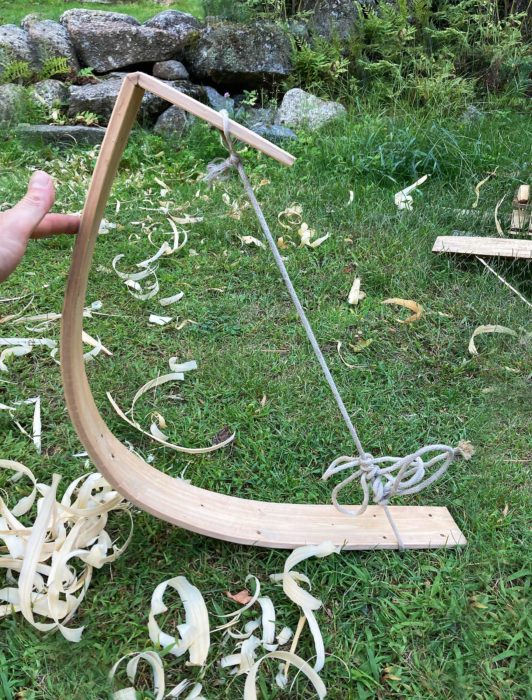 Reid Schwartz
Reid SchwartzCreating the stems was probably the hardest part of the construction. The tight bend at the top is created by cutting two V-shaped grooves into the inside face of the board and then bending the board across them under tension. If the grooves are too deep, the board will snap; too shallow and the extreme bend will be unattainable.
The trickiest part of the build was producing the stems. It took Reid five attempts to get them to bend to shape without breaking. “To produce symmetrical ends,” he explains, “both stems are bent as a single wide board. The board is bent to the arc of the stem profile” which is carved in the ends of the planking and then split into two matching pieces. Each of those is then split down the middle to sandwich the edges of the fabric at each end of the canoe. The upper end of the stem must be hard bent to about 90 degrees to lie parallel with the gunwale and form the peak at the bow. To achieve this bend, two V-shaped grooves are cut across the inside face, leaving a few growth rings intact to form the outside of the bend. Finding good grain and figuring out the right depth for the grooves was the key to getting a bend instead of a break.”
By late fall, Reid had all the parts shaped and ready. For his building bed, he used a flat patch of the lawn outside his house and laid out his tarp. Using tarp for his canoe’s skin also introduced new challenges, he says. “Instead of folding it or cutting gores to take up the extra skin as it comes to the gunwales, I subtly puckered it between temporary staples. Until I added the planking between the skin and the ribs it looked very ripply, but once the planking was in place, even though some puckering remains along the gunwales, overall, it’s very smooth. For the permanent attachment to the gunwales and stems, I used clench nails.”
Throughout the process—splitting and hewing a log to a rough balk, and then carefully shaving it to an even board—Reid used hand tools. “It goes from coarse to fine,” he says. “I start with a wedge or froe, then an axe, and finally, to the crooked knife,” the tool that started the whole adventure.
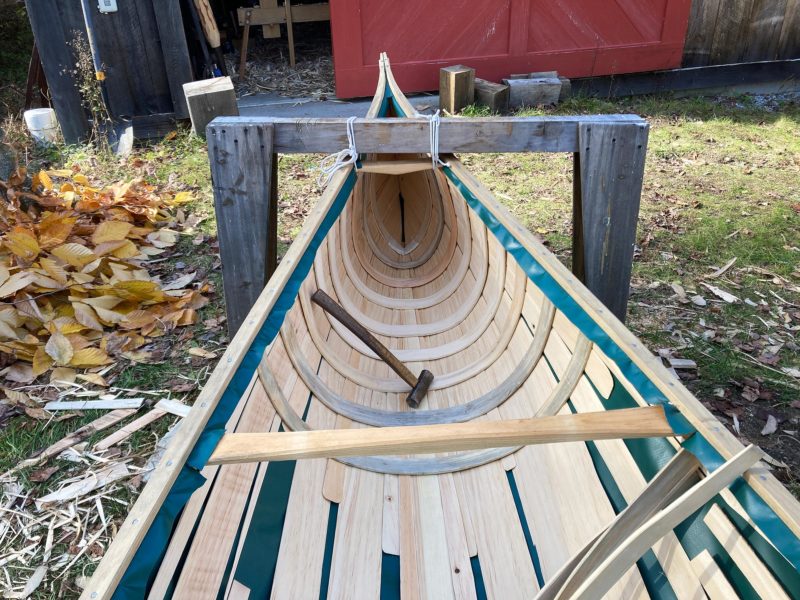 Reid Schwartz
Reid SchwartzFraming out the canoe. The pre-formed ribs are set in place, tapped up under the gunwales. As the builder works from stem to stem, finely-shaved staves are slid in between the ribs and the skin to create a strong, watertight boat.
Reid ribbed out the canoe on his 39th birthday at the end of October. Working alone, he would complete the entire build two weeks later. On November 5, 2022, he launched his tarp-skinned canoe. It is 15′ 6″ long, has a beam of 37 1⁄4″ and a depth amidships of 14 1⁄4″; it weighs just 48 lbs. Built of white pine, red spruce, balsam fir, and PVC tarpaulin, it was the culmination of an eight-year-long odyssey.
As canoes go, Reid’s is relatively narrow. “We are more accustomed to wide-bottomed canoes today, with nearly upright or tumblehomed sides and a very broad bottom that nearly matches the beam. But in native canoe building there are both wide- and narrow-bottomed canoes. Narrow canoes have more flare to the sides with the broadest part of the bottom being only two-thirds or less of the beam. They can have a hard or soft chine with a round, flat, or even shallow-V bottom. Mine is narrow with a soft chine and round bottom, which should be the most tender combination. But as I’ve used the canoe, I’ve discovered that it feels at its least stable when it’s upright, and as it leans to either side the stability quickly firms up against the flared sides.”
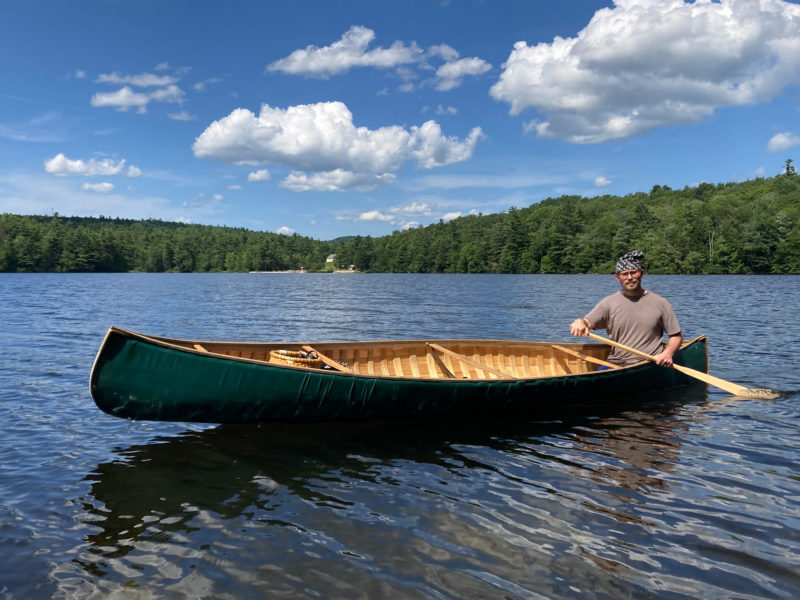 Cody Nowell
Cody NowellNormally, when paddling alone, Reid shifts his weight forward to just aft of the center thwart. That prevents the bow from lifting out of the water (as seen here) which reduces the waterline length and impacts the directional stability of the canoe.
It was not until spring, some months after the build, that Reid was able to use the canoe on a regular basis, but then he went out on the millpond nearly every day. With only his own weight in the canoe, he says, “I paddle from a kneeling position to keep gravity low and settle my weight off center to the port side just aft of the center thwart. That keeps the waterline as long as possible and gets me close to the gunwale for comfortable paddling. As the canoe tips it becomes more stable, feeling firmer as the gunwales lean harder toward the water. When I’m seated low and well aft, even the initial tenderness is pretty mellow, but shifting back to lean against the second thwart sacrifices some speed—with so much rocker, it’s easy to have the bow pop up out of the water and thereby lose some waterline length and speed. It’s still responsive to a J stroke, but it does have a slight propensity to oversteer when the bow is out of the water. That issue disappears completely with more weight aboard.”
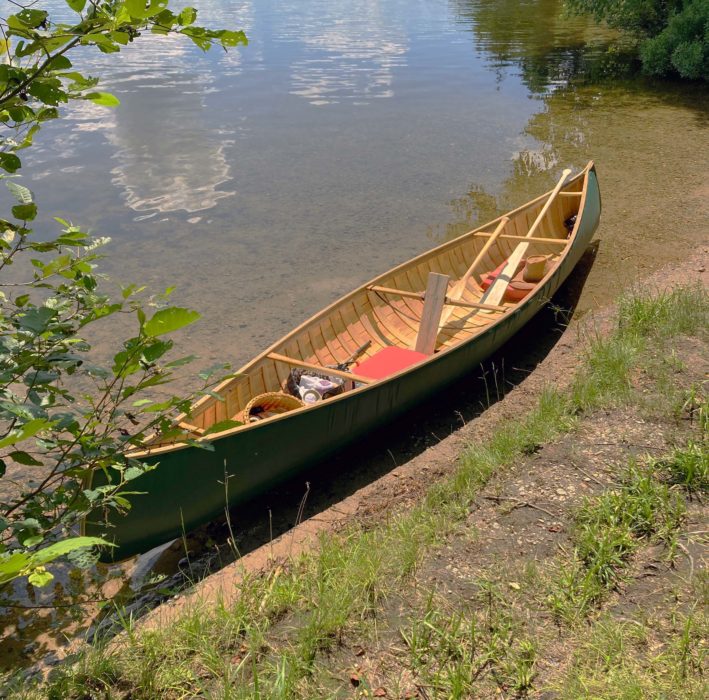 Reid Schwartz
Reid SchwartzDespite being narrow, Reid’s canoe is flat-bottomed enough that it will sit upright when beached, making it easy to load. The backrest is simply lashed to the center thwart so that it is easily removed and adjusted.
Before embarking on longer outings, Reid tested the canoe under load. “I added sandbags to the bow and forward middle sections, 25 lbs at a time. Any weight added to the bow greatly increased stability. With all my sandbags loaded plus the folding cart that I had used to bring them to the canoe, I had about 120 lbs on board with me. It brought the canoe to its waterline and made it feel extremely stable. Now I could move back to the most comfortable paddling position all the way aft, perched on the stern thwart. Sitting there is as comfortable as sitting in a chair, and the canoe is very narrow at that point, so I’m paddling as close to my body as possible with the paddle strokes working not far from the centerline. Tracking was very good. I was simply at ease and hugely impressed by the canoe’s stability.” It was, says Reid, a day of confidence boosting, and demonstrated that the canoe performed best when loaded. “It made perfect sense for a working boat,” he says. “Canoes were built to be picked up and carried, but they also needed to be load carriers. It was exciting to prove that in practice.”
As spring turned to summer, the rains came to New England and as the millpond dam burst twice within a month, Reid scaled back his boating, but he’d had enough time on the water to test the durability of the canoe’s tarp skin. “By June there were lots of scrapes and several gouges in it, but it seems they’re only superficial. The coating scuffs back to the woven-fiber core, but that stays intact. The millpond has quite a few sharp granite boulders lurking just beneath the surface. I’ve hung up, scraped, and crashed hard onto them. The flexibility of the tensioned ribs and floating planks seems to be very robust, and the canoe stayed as dry as can be.”
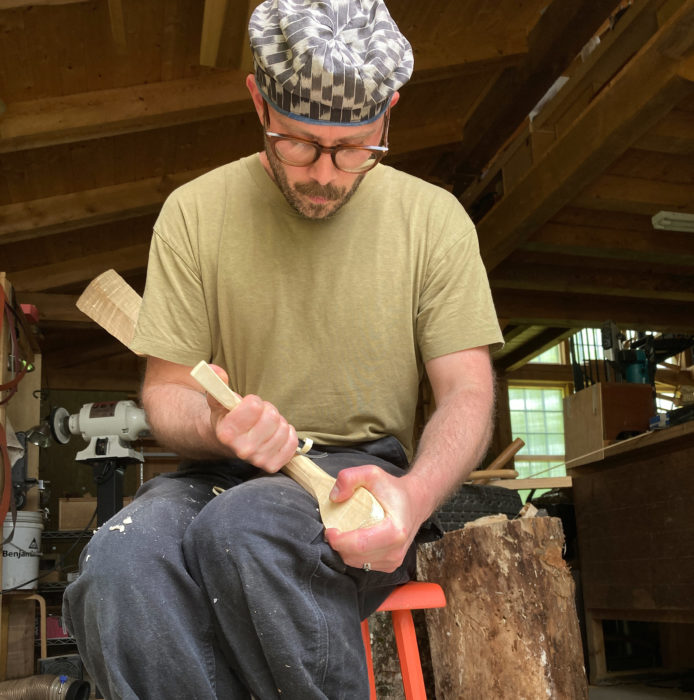 Cody Nowell
Cody NowellAfter rough-shaping the paddle with an axe, Reid fine-tunes with a crooked knife, holding the tool palm up and drawing it towards his body.
In the course of all his trials, Reid decided the thing he was not completely happy with, was the paddle. He had carved it to use on his 12′ birchbark canoe, which has less freeboard, and it was too short for the new boat. He decided to make a new one. Working in white pine, he hewed it to the outline and established the tapers and volumes with an axe before carving it to the finished dimensions with his crooked knife. He prefers a long, narrow paddle blade and says that he finds it appealing that “indigenous paddle design is rooted in the same anthropometric measurements as the canoe—everything is made to one’s own personal scale. The paddle’s blade width is limited to the span that can be comfortably gripped between the curled tips of the thumb and middle finger. This keeps the paddle from being so broad that the user pushes too much water and tires quickly. The long, narrow blade sacrifices power, but is conducive to the J stroke and the box stroke. The trade-off is worth it. I’ve even used it for sculling when I’ve needed to be completely silent on the water.”
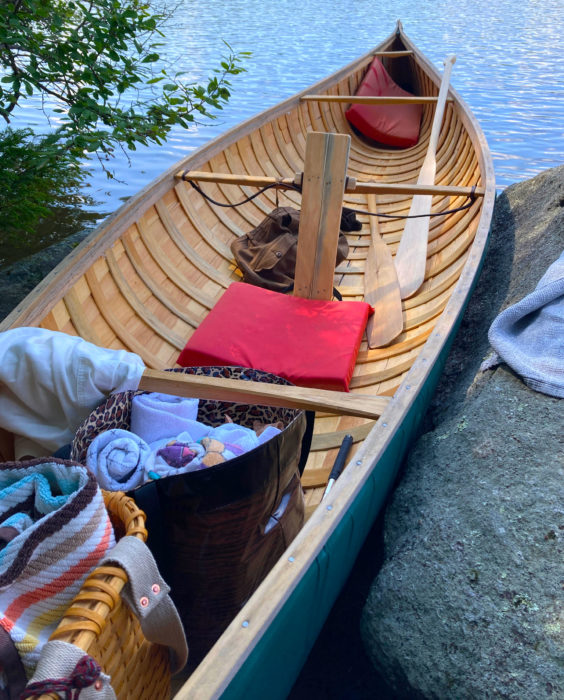 Reid Schwartz
Reid SchwartzWhile the canoe is relatively narrow, at 15′6″ long there is ample room for two passengers (plus toddler) and all their gear. By stowing the cargo in the bow, the weight is well distributed and the canoe is at its most stable.
With the paddle finished and the summer bark-harvesting season upon him, Reid set off through his family property in search of bark with which to make birchbark canisters that he plans to sell at a local craft event in the fall. With his tarp-skinned canoe he had a stable mode of transport with excellent load-carrying capability.
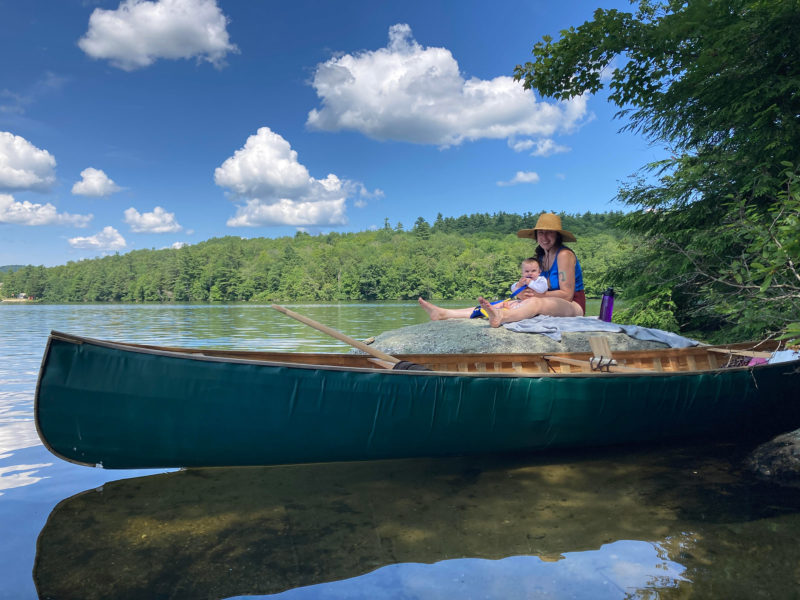 Reid Schwartz
Reid SchwartzFor a young family living in an area with many easily accessed freshwater lakes, the canoe is proving to be the ideal boat: light enough to get up onto the car roof rack without too much effort, stable enough to protect the passengers, and large enough to carry all the gear for a long day’s outing. The tarp skin has withstood bumping over rocks in the shallows and even coming in hard and getting stuck fast on a sharp-angled rock. The outer layer scuffs, but the weaving beneath remains intact.
He continued to use the boat almost every day, weather permitting, and in mid-July, finally took the family—himself, wife Cody, and toddler son—for a picnic outing. “We car-topped to a favorite lake,” Reid says, “packed a lunch, swimming gear, and all the baby stuff. We traversed the lake and cruised the shady side of a few coves before settling on a protruding rock for lunch. The canoe turns out to be the perfect family boat—it was a relaxed, happy day…the first of many.”![]()
Jenny Bennett is managing editor of Small Boats. When he’s not out on the water with his family, Reid Schwartz continues to make knives by hand and eye. He sells them via his website.
If you have an interesting story to tell about your adventures with a small boat, please email us a brief outline and a few photos.
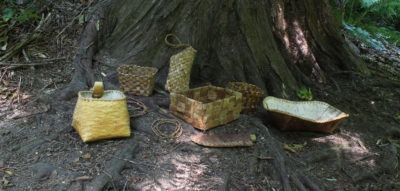
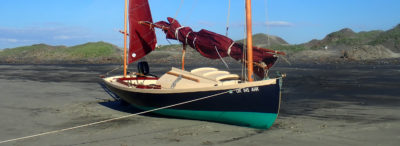
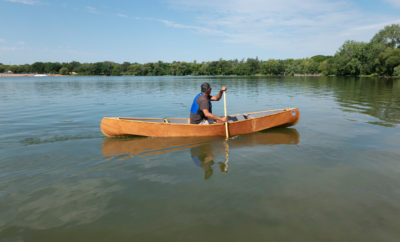
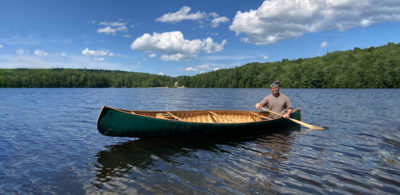
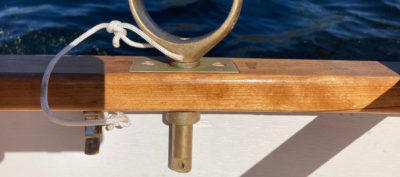
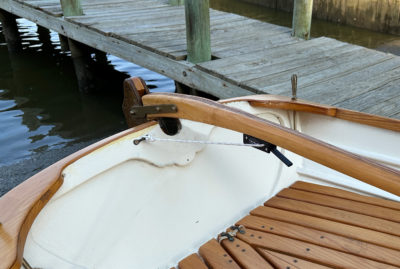
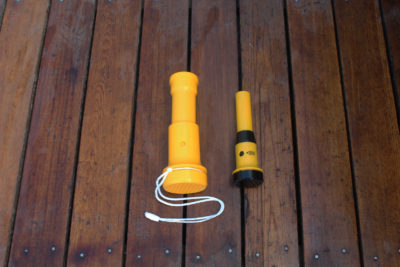
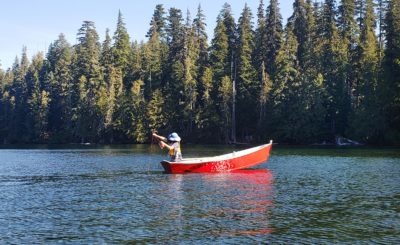
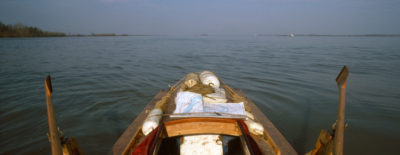
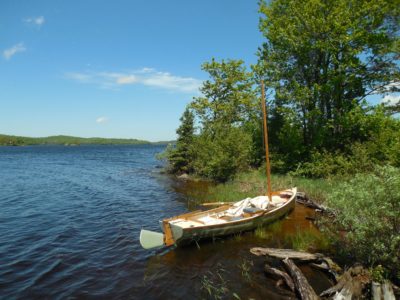
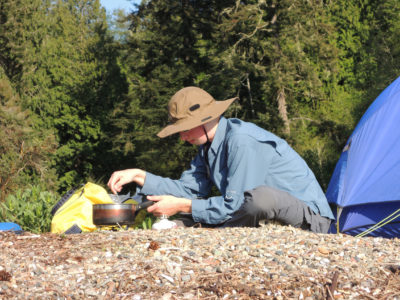
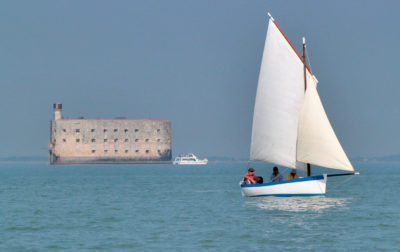
A timeless and beautiful boat. I hope you have many years of enjoyment!
A great project and great results!
Fine way of keeping the craft going without birchbark.
George Dyson uses a heavy grade of nylon to skin his aluminum-framed kayaks. The advantage is that he can heat shrink the fabric to make a smooth skin without creases or gores.
Very cool article. Love canoe-obsessed people:)